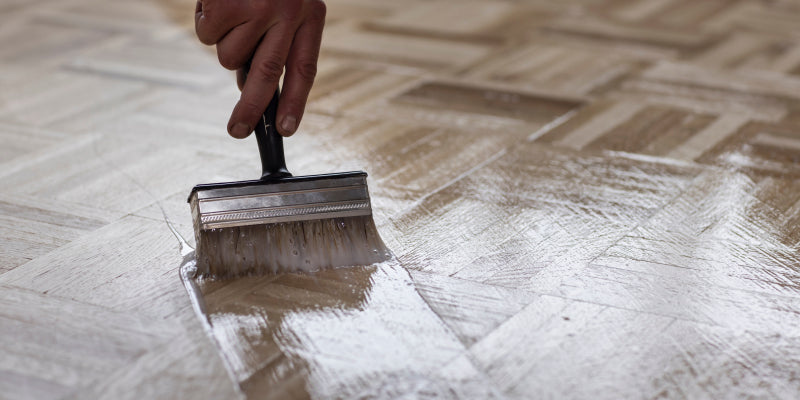
How to Prevent Scratches on Wood Floors
|
|
Time to read 4 min
|
|
Time to read 4 min
Whether you’re planning to install new hardwood flooring or you love the vintage wood flooring in your home, protecting it from wear and tear is essential. After all, wood floors are incredibly strong and durable, but all flooring experiences scratches and shows signs of wear over time. That’s why taking appropriate precautions is important. Follow these four tips to prevent scratches, keep wear to a minimum, and enjoy your beautiful wood floors for years to come.
Bold furniture can look striking against hardwood floors, but heavy tables, bookcases, sofas, and armchairs can easily scratch your floors if you aren’t careful. To keep furniture-related scratches and gouges minimal, make a point of lifting rather than pushing or sliding heavy furniture. After all, it’s easy to damage floors when moving or dragging furniture, so recruit a partner and move furniture safely.
Not all scratches result from moving furniture across a room. Minor shifts can add up, eventually creating deep gouges in your hardwood flooring. To prevent this type of damage over time, place pads or wheels underneath every table, chair, and sofa leg. Keep in mind that wheels allow for easier movement, but they could cause impact-related damage if you place them underneath particularly heavy pieces. Cork pads are best for heavy furniture you don’t plan to move, while felt furniture pads allow you to move chairs and coffee tables more smoothly.
For an extra layer of protection between the furniture and the hardwood flooring, consider placing area rugs throughout the room. Rugs can prevent heavy sofas and armchairs from scratching bamboo or hardwood floors, while adding color and visual appeal to the space. If you’re concerned about particularly heavy pieces leaving dents in the flooring below, add a carpet pad underneath your rug of choice.
In comparison to weighty items like sofas and sideboards, shoes may not seem like such significant threats to wood flooring. While footwear certainly doesn’t weigh as much as furniture does, it can still scratch the surface, especially if you install hardwood or bamboo flooring in high-traffic areas.
To shield wood flooring from shoes, consider asking family members and guests to refrain from wearing their shoes or at least certain types of footwear on your hardwood floors. Stilettos and cleats can be particularly damaging since their sharp edges can easily scratch both the finish and the wood itself.
While protecting wood floors from hard-soled shoes can help prevent damage, even sneakers and soft-soled shoes can cause scratches. Every time you walk across hardwood floors, you press grit, sand, rocks, and other substances into the floor, which can scratch the finish over time. To keep this type of damage minimal, place rugs inside exterior doors and encourage family members to wipe their feet.
Make a point of sweeping or vacuuming hardwood floors regularly to prevent gritty substances from accumulating and scratching the surface. Mopping can also help keep your floors clean but be sure the material can handle moisture before applying a wet mop. For example, most hardwood and engineered wood flooring can handle moisture, but water can damage bamboo flooring.
Whether you have dogs or cats, you want your pets to enjoy your hardwood floors as much as you do. While the average pet won’t deliberately scratch your floors, simply walking across a wood floor can cause damage, especially if your pet has longer claws.
To prevent your dog from scratching the floor, make a point of trimming its claws regularly. Whether that means more frequent trips to the groomer or weekly sessions with a pet-friendly nail file, keeping claws short and smooth can go a long way toward preventing unsightly scratches. Taking your dog for daily walks can also help with claw control, as walking on the pavement can file claws down naturally.
Keeping your cat’s claws neatly trimmed might not be as easy, but that doesn’t mean you can’t protect your floors adequately from pets. Rather than leaving wood floors bare and prone to scratches, try placing area rugs or floor runners on hardwood or bamboo floors. Pay attention to areas where your pets tend to tread and be sure to cover their usual pathways. You’ll protect the floor while providing your pets with a surface that’s easier for them to navigate.
To give your wood flooring the best possible chance of resisting scratches and other damage, it’s important to choose the most effective topcoats and finishes. Keep in mind that you can order many types of hardwood and bamboo flooring with additional protective layers, but you can also apply a more effective finish later. Some options for protecting wood floors are:
When you choose the highest quality wood flooring and prevent the surface from experiencing wear and tear, your floors can look and feel like new for years to come. Keep these tips handy to protect your wood floors from furniture, shoes, pets, and other types of objects that cause scratches.